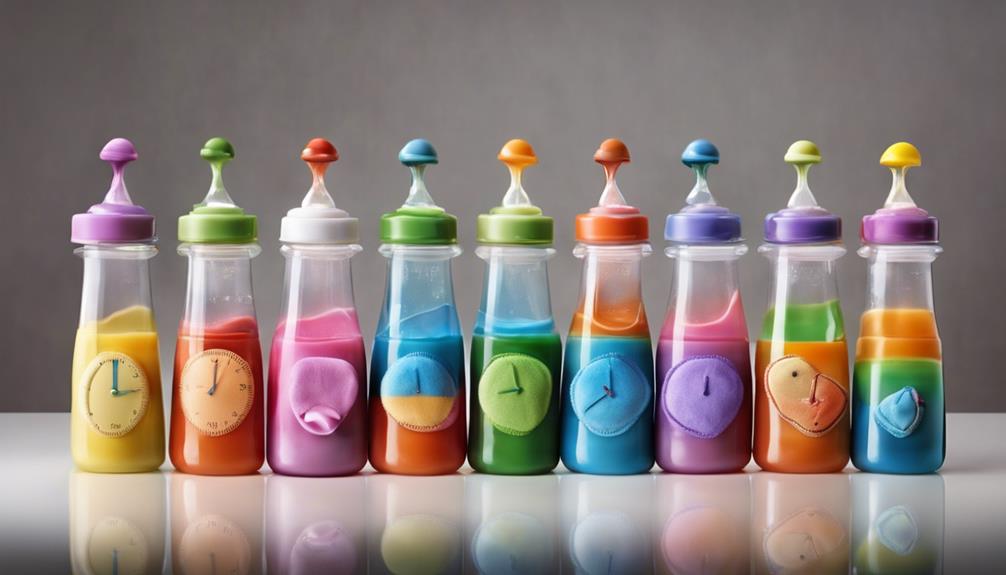Navigating the use of Mucinex while breastfeeding is like walking a tightrope – it’s all about balancing relief and caution.
Wondering how this popular remedy can impact you and your little one's health? Let's explore the nuanced considerations and practical steps to guarantee a safe journey through this medication landscape.
Key Takeaways
- Limited research on guaifenesin transfer to breast milk.
- Uncertain safety during breastfeeding, especially for infants under 2 months.
- Monitor for side effects in baby and self, seek medical help if needed.
- Consult healthcare provider for personalized dosing and potential interactions.
Risks of Taking Mucinex While Breastfeeding
While limited research has been conducted on the transfer of guaifenesin into breast milk, its safety during breastfeeding remains uncertain. Despite this uncertainty, usual maternal doses of Mucinex are generally considered unlikely to harm nursing infants, especially those older than 2 months. It's important to note that Mucinex itself doesn't contain alcohol, unlike some other medications, which can be important information for breastfeeding mothers. However, the specific effects of guaifenesin on lactation and breast milk aren't well-documented, underscoring the importance of seeking personalized advice from a healthcare provider.
When considering the risks of taking Mucinex while breastfeeding, consulting a healthcare provider for tailored guidance is paramount. Every individual's situation is unique, and obtaining personalized advice can help navigate any potential concerns regarding the safety of guaifenesin during breastfeeding. By proactively seeking guidance, breastfeeding mothers can make informed decisions that prioritize the well-being of both themselves and their nursing infants.
Dosage Guidelines for Mucinex Use

To guarantee safe and effective use of Mucinex while breastfeeding, it's essential to adhere to personalized dosage guidelines provided by a healthcare provider. Consulting a healthcare provider for specific dosage recommendations tailored to your individual needs is critical when considering the use of Mucinex during lactation.
It's important to follow the recommended dose indicated on the medication packaging to make sure safe use while breastfeeding. Dosage adjustments may be necessary based on factors such as weight, age, and medical history. Avoid surpassing the maximum daily dose of Mucinex to prevent potential side effects and risks to the breastfeeding baby.
Potential Side Effects to Watch For
When using Mucinex while breastfeeding, it's essential to be vigilant for potential side effects that may occur in either the breastfeeding mother or the baby. Here are three key points to take into account:
- Monitor Your Baby: Keep an eye out for any unusual symptoms in your baby such as irritability, drowsiness, or changes in feeding patterns while using Mucinex.
- Watch for Allergic Reactions: Look for signs of allergic reactions in your baby like rash, difficulty breathing, or swelling. If any of these symptoms are observed, seek immediate medical help.
- Take Note of Personal Health: Be attentive to your own health for potential side effects like nausea, dizziness, or stomach upset while taking Mucinex. If you experience any unexpected reactions, inform your healthcare provider promptly.
It's of utmost importance to prioritize safety and effectiveness when using Mucinex during breastfeeding. Consulting a healthcare professional if you have any concerns can help safeguard the well-being of both you and your baby.
Interactions With Other Medications

Interactions with other medications should be carefully considered before using Mucinex while breastfeeding to guarantee safe and effective treatment.
Guaifenesin, the active ingredient in Mucinex, can interact with blood thinners, potentially increasing the risk of bleeding.
Combining guaifenesin with cough suppressants or expectorants can lead to additive effects or interactions, affecting the overall effectiveness of the medications.
It's important to be aware that guaifenesin may also impact the results of certain lab tests, so informing your healthcare provider about its use is vital before undergoing any tests.
To make safe usage, avoid mixing multiple products containing guaifenesin as this can heighten the risk of drug interactions.
Consulting with your healthcare provider or pharmacist is advisable to discuss any potential medication interactions that could arise from using Mucinex while breastfeeding.
Prioritizing these precautions can help maintain the health and well-being of both you and your baby during this period.
Tips for Ensuring Safe Breastfeeding Practices
Considering the potential interactions with other medications, it's important to adopt specific tips to guarantee safe breastfeeding practices while using Mucinex.
- Consult Your Healthcare Provider: Before taking Mucinex while breastfeeding, it's essential to consult your healthcare provider. They can offer guidance on proper dosing and guarantee the safety of both you and your baby.
- Choose Phenylephrine-Free Mucinex Products: Opt for Mucinex products that don't contain phenylephrine. This can help avoid any potential adverse effects on milk production and your baby's health.
- Prioritize Natural Remedies: Consider natural remedies such as rest, hydration, and humidifiers as alternatives to Mucinex while breastfeeding. These remedies can help alleviate symptoms while minimizing the need for medications.
Frequently Asked Questions
Is It OK to Take Mucinex While Breastfeeding?
Yes, it's generally safe to take Mucinex while breastfeeding, but consulting a healthcare provider for dosing guidance is vital. Limited research exists, so personalized advice is recommended to guarantee the baby's safety.
What Can I Take to Break up Mucus While Breastfeeding?
When breastfeeding, it's wise to stay hydrated to naturally break up mucus. A humidifier in the room can also help. For specific concerns, consulting a healthcare provider is important to guarantee safety for both parent and baby.
What Is the Safest Decongestant for Breastfeeding?
When breastfeeding, the safest decongestant is one without phenylephrine, like Mucinex. Guaifenesin in Mucinex is generally considered safe. Prioritize natural remedies, but for mucus relief, Mucinex can be a suitable choice after consulting a healthcare provider.
How Long After Taking Decongestant Can I Breastfeed?
After taking a decongestant, it's generally recommended to wait 2-4 hours before breastfeeding to minimize infant exposure. Personalized advice from a healthcare provider is key due to variations in medication. It helps lower risks for the baby.
Can I Use Mucinex While Breastfeeding if I Can’t Take Pepto Bismol?
Yes, you can safely use Mucinex while breastfeeding if you can’t take Pepto Bismol. It is recommendable to consult with a healthcare professional for personalized advice.
Conclusion
To sum up, it's important to be mindful of how we care for ourselves while breastfeeding. By following the recommended guidelines and staying vigilant for any potential side effects, we can safely incorporate Mucinex into our routine.
Remember to prioritize rest, hydration, and consult with a healthcare provider if you have any concerns. Taking care of ourselves ultimately benefits both us and our little ones.










